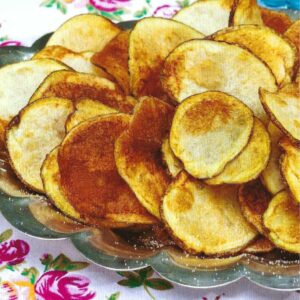 Potato chips are a beloved snack enjoyed worldwide, but have you ever wondered about their origin? This crispy, salty treat has a fascinating history that dates back to the mid-19th century. Let’s dive into how potato chips started as the saratoga chip to become the popular snack we know today.
Potato chips are a beloved snack enjoyed worldwide, but have you ever wondered about their origin? This crispy, salty treat has a fascinating history that dates back to the mid-19th century. Let’s dive into how potato chips started as the saratoga chip to become the popular snack we know today.
The Birth of the Potato Chip
The invention of potato chips is often attributed to George Crum, a chef at Moon’s Lake House in Saratoga Springs, New York, in 1853. Legend has it that a demanding customer (some say it was railroad magnate Cornelius Vanderbilt) complained about thick, soggy fried potatoes. In response, Crum sliced potatoes paper-thin, fried them to a crisp, and seasoned them heavily with salt. To his surprise, the customer loved them, and “Saratoga Chips” were born.
From Saratoga to Nationwide Sensation
Initially known as “Saratoga Chips,” these crispy potato slices quickly gained popularity beyond the confines of Moon’s Lake House. By the late 1870s, several companies began mass-producing potato chips. Notably, William Tappendon of Cleveland, Ohio, started making chips in his kitchen and delivering them to local grocery stores in 1895, marking the beginning of the potato chip industry.
The Rise of Potato Chip Brands
As potato chips gained popularity, various brands emerged:
1. Lay’s: Founded by Herman Lay in 1932, Lay’s became one of the first national potato chip brands.
2. Utz: It was started in 1921 by William and Salie Utz, who made chips in their kitchen.
3. Wise: Founded in 1921 by Earl Wise Sr., who initially sold potato chips to use excess potatoes from his family’s grocery store.
Innovations in Flavor and Packaging
The mid-20th century saw significant innovations in the potato chip industry:
1. Flavored chips: In the 1950s, Joe “Spud” Murphy of the Irish company Tayto developed technology to add seasoning during manufacturing, introducing cheese & onion flavored chips.
2. Packaging improvements: Laura Scudder introduced cellophane bags in 1926, which helped keep chips fresh longer, while nitrogen-filled bags in the 1950s further improved shelf life.
Global Expansion and Variations
As potato chips spread globally, regional variations emerged:
1. United Kingdom: Known as “crisps,” with unique flavours like prawn cocktail and cheese & onion.
2. Japan: Offering seaweed, wasabi, and soy sauce flavours.
3. India: Featuring spicy and tangy flavours like masala and tamarind.
Nutritional Concerns and Healthier Alternatives
In recent years, health concerns have led to the development of:
1. Baked chips: Offering lower fat content than traditional fried chips.
2. Veggie chips: Made from vegetables like beets, carrots, and sweet potatoes.
3. Kettle-cooked chips: Perceived as more natural and less processed.
The Enduring Legacy of Potato Chips
Today, potato chips remain a global snack food favourite. The industry continues to innovate with new flavors, healthier options, and sustainable packaging. From their humble beginnings in Saratoga Springs to becoming a multi-billion dollar industry, potato chips have truly made their mark in snack food history.
Whether you prefer classic salted, bold flavours or healthier alternatives, the next time you crunch into a potato chip, remember the rich history behind this simple yet iconic snack. From Saratoga Chips to the diverse options available today, potato chips have come a long way, satisfying snack cravings for over 160 years.
Saratoga Chips
Equipment
Ingredients
- 3 large Yukon Gold potatoes washed and peeled
- 2 cups Lard or vegetable oil for frying
- 1 tsp. Salt
Instructions
- Slice the potatoes with a mandoline or sharp knife into very thin slices (¼ inch thick or thinner). The slicing attachment of a food processor works well too. Place the sliced potatoes in a large bowl of ice water for at least 10 minutes. Drain and pat dry with paper towels.
- Heat 2 cups of lard or vegetable oil in a large cast-iron or saute pan over mediumhigh heat When shimmering, carefully add 5 or 6 slices of potato. Use long tongs to separate and cook on one side until they are a delicate yellow color, about 3-4 minutes. Turn and brown on the other side, another minute or two. (fhe hot lard or oil may splatter, so it's best to do this while wearing a kitchen mitt.)
- Remove the potato slices with tongs or a slotted spoon and drain on a baking sheet or large tray lined ·with paper towels. Sprinkle with salt. Continue with the remaining potatoes. Serve warm or room temperature.
Notes
-DINING ROOM AND KITCHEN (1891).
Learn More About Recipes from the Gilded Age

